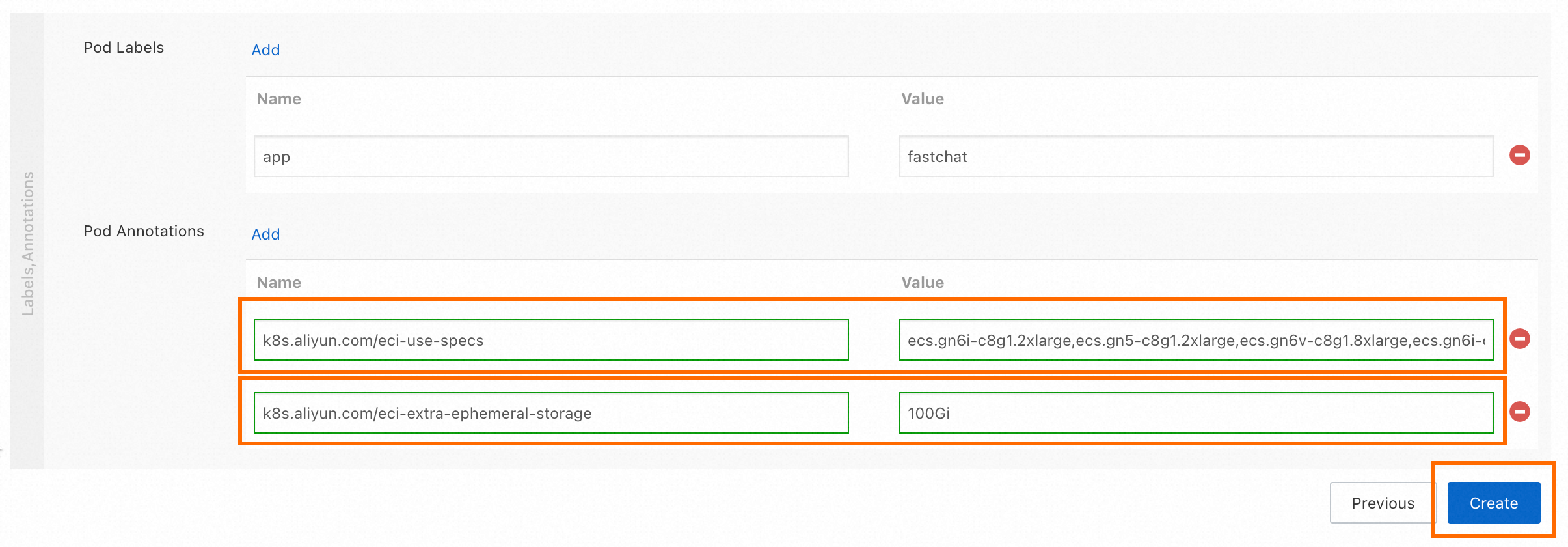This topic describes how to deploy a FastChat application to experience AI-generated content (AIGC) in a ACK Serverless cluster. You can use the Container Service for Kubernetes (ACK) console or kubectl to deploy the application and then access FastChat through an external endpoint to experience AIGC.
Prerequisites
An ACK Serverless cluster is created in the China (Beijing), China (Hangzhou), China (Shanghai), or China (Shenzhen) region and Internet access is enabled for the cluster. For more information, see Create an ACK Serverless cluster.
Introduction to FastChat
FastChat is an intelligent and easy-to-use chatbot for training, serving, and evaluating large language models. FastChat is a RESTful API-compatible distributed multi-model service system developed based on advanced large language models, such as Vicuna and FastChat-T5. FastChat provides a web interface and OpenAI.
Alibaba Cloud does not guarantee the legitimacy, security, or accuracy of the third-party model FastChat. Alibaba Cloud shall not be held liable for any damages caused by the use of FastChat.
You must abide by the user agreements, usage specifications, and relevant laws and regulations of FastChat. You shall bear all consequences resulting from the legitimacy and compliance requirements of FastChat.
Step 1: Deploy the FastChat application
You can use the ACK console to deploy the FastChat application, or connect a kubectl client to the ACK Serverless cluster and then create a YAML file to deploy the application.
Use the ACK console
Log on to the ACK console. In the left-side navigation pane, click Clusters.
On the Clusters page, click the name of the cluster that you want to manage and choose in the left-side navigation pane.
On the Deployments page, click Create from Image.

On the Basic Information wizard page, enter an application name, such as fastchat, add annotations, and then click Next.

On the Container wizard page, configure the General, Health Check, and Lifecycle settings, and then click Next.
Category
Parameter
Example
Screenshot
General
Image Name
yunqi-registry.cn-shanghai.cr.aliyuncs.com/lab/fastchat

Image Version
v1.1.0
Health Check
Readiness
Enable readiness check, use TCP connections, and set the pod port to 7860.

Lifecycle
Command
Set the container startup command to
["sh","-c","/root/webui.sh"].
On the Advanced wizard page, click Create to the right of Services.

In the Create Service dialog box, configure the Service parameters and click Create to use the Service to expose the FastChat application.
Parameter
Example
Screenshot
Name
fastchat-svc

Type
Select Server Load Balancer, Public Access, and Create SLB Instance.
Service Port
7860
Container Port
7860
In the Labels and Annotations section, add the pod annotations in the following table and click Create in the lower-right part of the page.
Name
Value
k8s.aliyun.com/eci-use-specs
ecs.gn6i-c8g1.2xlarge,ecs.gn5-c8g1.2xlarge,ecs.gn6v-c8g1.8xlarge,ecs.gn6i-c16g1.4xlarge
k8s.aliyun.com/eci-extra-ephemeral-storage
100Gi

If the following information is returned, the application is created.

Use kubectl
A kubectl client is connected to the ACK Serverless cluster. For more information, see Obtain the kubeconfig file of a cluster and use kubectl to connect to the cluster.
Create a file named fastchat.yaml and copy the following content to the file:
apiVersion: apps/v1 kind: Deployment metadata: labels: app: fastchat name: fastchat namespace: default spec: replicas: 1 selector: matchLabels: app: fastchat template: metadata: labels: app: fastchat alibabacloud.com/eci: "true" annotations: k8s.aliyun.com/eci-use-specs: ecs.gn6i-c8g1.2xlarge,ecs.gn5-c8g1.2xlarge,ecs.gn6v-c8g1.8xlarge,ecs.gn6i-c16g1.4xlarge k8s.aliyun.com/eci-extra-ephemeral-storage: 100Gi spec: dnsPolicy: Default containers: - command: - sh - -c - "/root/webui.sh" image: yunqi-registry.cn-shanghai.cr.aliyuncs.com/lab/fastchat:v1.1.0 imagePullPolicy: IfNotPresent name: fastchat ports: - containerPort: 7860 protocol: TCP readinessProbe: failureThreshold: 3 initialDelaySeconds: 5 periodSeconds: 10 successThreshold: 1 tcpSocket: port: 7860 timeoutSeconds: 1 resources: requests: cpu: "8" memory: 16Gi limits: nvidia.com/gpu: 1 --- apiVersion: v1 kind: Service metadata: annotations: service.beta.kubernetes.io/alibaba-cloud-loadbalancer-address-type: internet service.beta.kubernetes.io/alibaba-cloud-loadbalancer-instance-charge-type: PayByCLCU name: fastchat-svc namespace: default spec: externalTrafficPolicy: Local ports: - port: 7860 protocol: TCP targetPort: 7860 selector: app: fastchat type: LoadBalancerRun the following command to deploy the FastChat application:
kubectl apply -f fastchat.yamlRun the following command to query the status of the application:
kubectl get deployment fastchatExpected output:
NAME READY UP-TO-DATE AVAILABLE AGE fastchat 1/1 1 1 38m
Step 2: Access the Service
Log on to the ACK console. In the left-side navigation pane, click Clusters.
On the Clusters page, click the name of the cluster that you want to manage and choose in the left-side navigation pane.
Click the external endpoint in the External Endpoint column of the Service named fastchat-svc in the Service list, such as
47.107.XX.XX:7860.
You can then access the FastChat application and experience AIGC.

Step 3: Release resources
To avoid incurring unexpected fees, delete the resources at your earliest convenience after you use the application.
Delete the application and Service
On the Clusters page of the ACK console, click the name of your cluster. In the left-side navigation pane, choose Workloads > Deployments, find the FastChat application, and then choose More > Delete in the Actions column.

In the Confirm dialog box, select Delete Associated Service fastchat-svc and click OK.
Delete a cluster
ACK Serverless clusters are in public preview. You can use ACK Serverless clusters free of charge. If your ACK Serverless clusters use other Alibaba Cloud services, you need to pay for these services based on their billing rules. Fees are charged by these services separately. After you complete the configuration, you can manage the cluster in one of the following ways:
If you no longer need the cluster, log on to the ACK console. On the Clusters page, choose More > Delete in the Actions column of the cluster to delete the cluster. In the Delete Cluster dialog box, select Delete ALB Instances Created by the Cluster, Delete Alibaba Cloud DNS PrivateZone instances Created by the Cluster, and I understand the above information and want to delete the specified cluster, and then click OK. For more information about how to delete an ACK Serverless cluster, see Delete a cluster.
Continue to use the cluster. For more information about the billing rules of other cloud services that may be used by ACK Serverless Pro clusters, see Cloud service fee.
Contact Us
If you have any questions about enabling AIGC services for ACK, join the DingTalk group 31850017754.